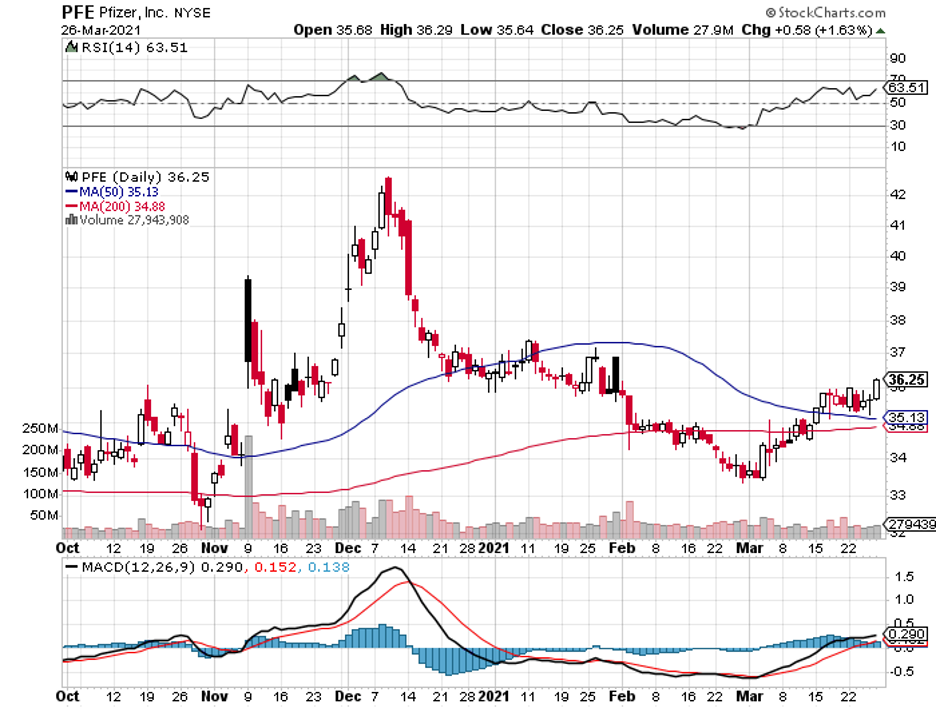It’s virtually impossible to find a period in history when drug development gained the unmitigated attention of the whole world.
Yet, this is exactly what happened in 2020 when we all waited with bated breath for the results of COVID-19 trials from the likes of Pfizer (PFE), BioNTech (BNTX), Moderna (MRNA), AstraZeneca (AZN), Johnson & Johnson (JNJ), and Novavax (NVAX).
Despite this, it is astounding that biopharmaceutical stocks are cheaper than they have ever been in the past 20 years.
Given the fact that its collaboration with BioNTech made a central figure in the COVID-19 vaccine race, I think it’s best to put a spotlight on Pfizer today.
Pfizer was the first biopharmaceutical company to successfully market a COVID-19 vaccine, BNT162b2.
Recently, Pfizer received another good news. The FDA is no longer demanding that the company transport BNT162b2 at ultra-low temperatures.
When Pfizer revealed its strong results last year, the world was impressed and no one barely noticed the ultra-cold storage requirement that the achievement entailed.
But with competitors already gaining approvals as well, this particular requirement started to pose noticeable challenges to Pfizer’s vaccine supply chain and made it extremely challenging transporting the much-needed vaccines to remote areas.
These challenges highlight the significance of the recent FDA announcement regarding BNT162b2.
In terms of market share, Pfizer holds a significant advantage over the others.
As of the year-end of 2020, the company supplied 65 million doses to developed markets.
Meanwhile, the 2021 forecast for this product is at nearly 2 billion doses. This is estimated to rake in roughly $15 billion in revenue for Pfizer.
In comparison, Moderna’s advanced purchase deals are estimated to be worth $18 billion.
To sustain immunity, there’s the possibility that the vaccine would be needed annually.
This could lead to substantial demand for doses, with a two-dose vaccine like BNT162b2 projected to reach about 10 billion doses every year.
Realistically, the rising need for doses and the manufacturing requirements will obviously pressure profit margins.
However, if the vaccine does turn out to be an annual necessity, then it could become a valuable asset.
The entire COVID-19 market is estimated at $39 billion in 2021 and $23 billion in 2022.
Pfizer and even Moderna’s first mover advantage can easily help them dominate the market this year.
This means that the competition will heat up by 2022.
To ensure that it keeps the lead, Pfizer has commenced the Phase 1 trial for a COVID-19 pill.
Pfizer’s pill, dubbed PF-07321332, aims to inhibit the enzymes that cause the SARS-CoV-2 virus to replicate. The goal is to create an antiviral drug that works pretty much the same way as the one developed for HIV and Hepatitis C.
If the trials generate positive results, then PF-07321332 could be taken at the first sign of infection.
So far, lab results have shown the pill’s potent capacity to prevent the SARS-CoV-2 virus and other coronaviruses from replicating.
Pfizer isn’t the only one that came up with the idea of a COVID-19 pill. Merck (MRK), Eli Lilly (LLY), and Regeneron (REGN) have been conducting tests for their own version of the antiviral.
However, Pfizer is more than its COVID-19 programs.
In the past, investors wondered about the long-term growth potential of this company. Some questions are linked to its Upjohn unit, which included several products that lost patent exclusivity.
This segment clouded Pfizer’s pure play revenue and even its earnings growth. However, these questions were put to an end last year when Upjohn’s finally separated from Pfizer and formed a new company, Viatris (VTRS), with Mylan.
The effect of this move showed an amplified growth for Pfizer almost immediately.
In the fourth quarter alone of 2020, the company reported $11.68 billion in revenue, indicating a 12% increase year-over-year. If we exclude the sales from the COVID-19 vaccine, Pfizer’s revenue was still up by 8%.
Every key product segment in the company recorded revenue growth, which is remarkable considering the effects of the pandemic.
Revenue for its oncology sector went up 23% to reach $3 billion, with breast cancer treatment Ibrance leading the charge with an 11% boost to its sales to hit $1.4 billion.
To ensure that it corners the market, Pfizer also launched biosimilars Zirabev and Ruxience in the same quarter. Both generated $171 million in total.
Outside its COVID-19 program, other products in Pfizer’s vaccine segment significantly contributed to the 17% increase in revenue to reach $2 billion.
For example, the pneumonia vaccine Prevnar generated $1.8 billion thanks to the 10% boost in its revenue year-over-year.
As for Pfizer’s rare disease unit, revenue went up 24% to reach $865 million.
The segment leader so far is cardiomyopathy treatment Vyndagel, which achieved a jaw dropping 96% year-over-year boost in its revenue to generate $429 million. This product won’t face patent loss until 2026, so Pfizer still has a few more years to take advantage of it.
Pfizer’s revenues in 2020 were up 2% at $41.9 billion. Considering that it still managed to boost sales despite the pandemic, there’s a good chance that 2021 will be a better year for the company.
In fact, Pfizer estimates that it would reach nearly $60 billion in revenue, with an annualized EPS of roughly $3.15 in 2021.
Global sales in the biotechnology and healthcare industry are projected to be worth $1.2 trillion annually. This is a massive market that is all but guaranteed.
The S&P 500 trades at nearly 21.5x forward earnings, with pharmaceutical companies trading at only 13.2x. That’s a whopping 60% discount.
Considering that drug stocks have historically traded at roughly the same level as the S&P 500, the current situation still offers an unmistakable promise even if nothing else happens.
Continuous development in the sector not only advances our quality of life but also offers reasonable returns to investors.



